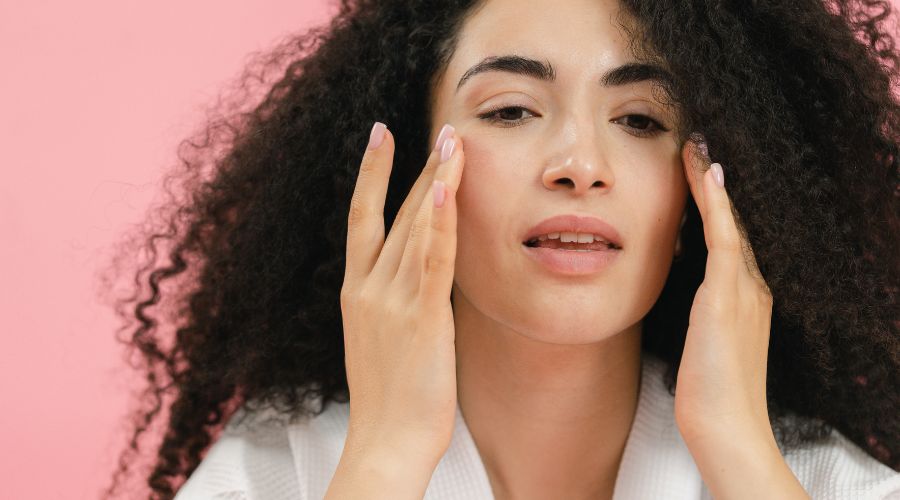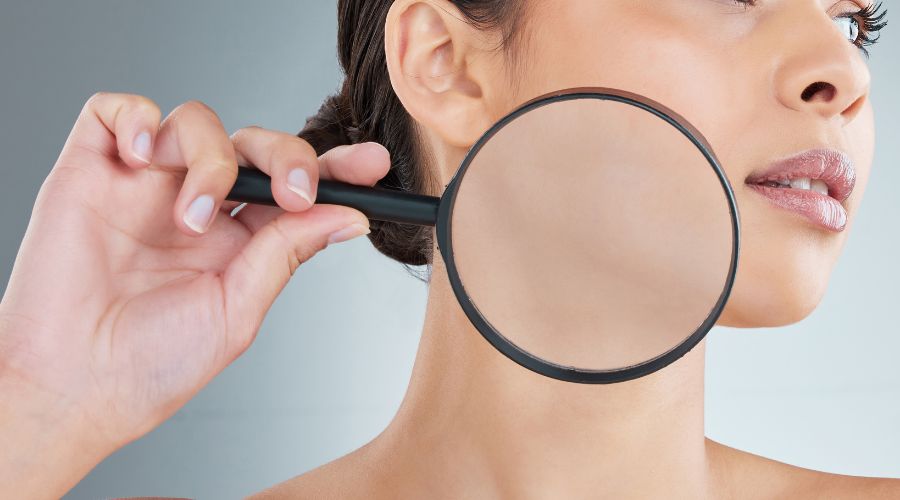Taking care of the skin is crucial because it is a vital component of the body. Knowing your skin type is a prerequisite for acquiring complete care. Genetics is what determines the type of skin, yet it will also be influenced by other factors and can change over time. Normal, dry, oily, and combo skin are the four basic types of healthy skin. Nearly everyone experiences greasy skin occasionally. Some oil is good since your skin naturally creates it to moisturise and protect your skin but the issue develops when you have too much oil on your skin. For those who struggle with oily skin that leads to breakouts, finding products specifically made for your skin type is essential. Oil-free and non-comedogenic options can help reduce the risk of clogged pores, blackheads, and other skin imperfections caused by excessive oil production.
Uncertain about the best ways to handle oily skin? Oh, where should we begin? Greasy, oily skin is the root of beauty issues. Therefore, while having a glossy sheen on your hair and nails may be beautiful, having one on your face is not as attractive. The thing about having oily skin is that there isn’t one specific cause for the excess layer of oil on your face. Your sebaceous glands are hyperactive and produce more oil than you need. It frequently results from hormonal changes, hereditary factors, poor nutrition, stress, or even the use of inappropriate skincare products. Not to mention the instances in which your skin produces excessive amounts of oil to make up for the moisture loss. Result? Enlarged pores are prone to blackheads, acne, and other skin problems. A nightmare indeed!
But that doesn’t imply you can’t do something about having oily skin. Before anything else, consider what works for you rather than replicating what others are doing. Stick to tried-and-true oily skin products instead of experimenting with new products, which could make your condition worse. To create the best skincare regimen for oily skin, we looked closely at the origins, symptoms, and treatments of oily skin.
Continue reading to learn the best skincare regimen for oily skin and practical advice for controlling the extra oil.
1. What Causes Oily Skin?
 Although the causes of oily skin vary depending on your gender and skincare regimen, there are certain common underlying causes of greasy skin:
Although the causes of oily skin vary depending on your gender and skincare regimen, there are certain common underlying causes of greasy skin:
- Genetics may lead to oily skin. The oily skin may run in families. You are more likely to have oily skin if one of your parents has one.
- The time of year and the location where you live can also have an impact on your skin. Most people that live in hot, humid areas have oilier skin. Compared to winter, the summer is when you’re most likely to have oilier skin.
- Your pores may enlarge as you get older, lose weight, or have breakouts in the past. More oil is typically produced by bigger pores.
- Using incorrect skin care products might result in oily skin. Some people mistake oily skin for combination skin, leading them to use excessively thick lotions. You may need to adjust your skincare routine for the spring and summer to include lightweight moisturisers and gel-based cleansers if you experience drier skin throughout the winter. The amount of oil that remains on your face can be significantly reduced by using the right skincare products.
- Skipping using moisturiser is not a good idea. The assumption that moisturiser leads to greasy skin is incorrect. You should use a decent moisturiser to prevent your skin from drying out if you’re using acne treatments like salicylic acid or benzoyl peroxide. Any type of skin will get dry without a moisturiser. Finding the correct type of moisturiser is therefore crucial rather than skipping it altogether. Oily skin responds effectively to lightweight, water-based moisturisers.
- A bad practice is overdoing your skin care regimen, over-washing your face or over-exfoliating can also result in oily skin. The goal of washing and exfoliating your face is to remove oil. However, if you do this frequently, your skin loses too much oil. To control excess oil, you only need to wash your skin twice per day. Your skin may become more oily and dry out if you don’t wear sunscreen. Wear sunblock every single day.
2. Do’s & Don’ts For Oily Skin

The effectiveness of your skincare regimen greatly influences how your skin looks. You can control overactive oil glands by making a few adjustments to your everyday routine.
Do’s: You should complete the following steps daily in the morning after you wake up and at night before you sleep.
Morning Rituals: To treat oily skin, you should perform these procedures every morning. They’ll help you look oil-free all day.
- STEP-1 Cleansing: While you sleep, leftovers from your hair products and the pillowcase can cause your face to become clogged with oil and other debris. Use warm water to open your pores as soon as you are awake. Wash your face with a cleanser that has the potent ingredient salicylic acid which penetrates oil to stop breakouts and congested pores, keeping your face clear and less greasy.
- STEP-2 Toning: A toner is a simple skincare product that can help reduce pore size and manage oil. To refine pores and stop acne outbreaks, use an oil-fighting toner one to three times a day after cleansing.
- STEP-3 Moisturising: Use a light moisturiser on your skin after cleansing, exfoliating, and toning it to keep it moisturised and protected during the day. For your skin to remain healthy for the rest of your life, moisturising is crucial.
- STEP-4 Sunscreen: Avoid being in the sun directly because it might irritate your skin and cause inflammation. If you’re going to be outside in the sun, always wear sunscreen. For oily skin, search for lightweight solutions that won’t contribute to the oil on your skin.
Night Time Rituals: These steps should be followed at night as well to keep your skin oil-free. Putting these into your routine will offer you beautiful skin and a more youthful appearance.
- STEP-1 Remove your Makeup: Just as crucial as your morning skincare routine is your nightly one. Start your nighttime ritual with a makeup remover if you are wearing makeup. To keep your skin clean, it’s crucial to remove your makeup at the end of the day.
- STEP-2 Cleansing: To get rid of any accumulation of dirt, debris, and oil from the remainder of the day, remember to wash your face as well at the end of the day to clear pore clogging and aid in preventing outbreaks and acne.
- STEP-3 Moisturise: Even though it may seem illogical to provide extra moisture to oily skin, regular moisturising stops your skin from going into overdrive when it gets too dry and overcompensates with an excess of oil.
Don’ts: When practising your skincare routine, be sure to keep these points in mind.
- Using too much water when washing your face can make it generate more oil, so limit yourself to twice daily.
- It can irritate your skin if you rub your face dry after cleansing.
- Use a towel or washcloth gently on your face to dry it instead or use blotting sheets or washing cloths.
- When you’re out, keep cleaning clothes in your purse or backpack.
- Excessive exfoliation might irritate your skin, so limit it to no more than twice a week.
3. Makeup Tips For Oily Skin

Prep Before Makeup: As you apply makeup to your skin, keep these things in mind. Skin damage can result if these instructions are not followed:
- Follow Your Morning Routine: Your face should be well-cleaned. It is ideal to start your makeup application on a clean, well-hydrated surface. To get rid of the oil and grime from the top layer of your skin, rinse your face with warm water. Then use a toner. Apply an oil-free toner liberally to a cotton ball. Keep the cotton ball away from your eyes while you wipe your face and let the merchandise air dry. Now, moisturise your face. Your face should be moisturised lightly with a thin layer. Using matte moisturisers can aid in absorbing extra oil from your face. For added security, choose a moisturiser with SPF. With the help of these items, your makeup won’t melt off of your face.
- Apply a Matte Primer: A smooth, shine-free base for your makeup is provided by primer. Choose a mattifying, oil-free primer that is available in powder or liquid-to-powder form. Don’t forget to apply eyelid primer as well. Use a decent primer to prepare oily skin. One without a lot of silicone would be ideal. Primers, which frequently contain fillers, “may be a breeding environment for acne and inflammation.” Also, do not use a single primer for the entire face, use different primers instead as that will cater to the needs of the various areas of your face.
- Conceal Your Blemishes: Breakouts and pimples are more likely to occur on oily skin. Liquid matte concealer used in thin layers will help to cover these flaws without triggering new breakouts. To conceal your red marks, dark circles, and flaws, use the wand or a concealer brush. Cream concealers should be avoided since they will clog your pores.
- Use A Foundation Designed For Oily Skin: Before buying the foundation, carefully check the label to ensure that it is oil-free, mattifying, and non-comedogenic. Use circular and dabbing motions with the brush. Use a liquid foundation with a water base if you dislike a powder foundation. A glowy, liquid foundation product works well for oily skin since it helps to hide texture.
- Add a Finishing Powder: For oily skin, using a mattifying powder is a fantastic alternative. The one with chemicals that help reduce shine and oil production is the best. Matte translucent powder offers yet another defence against greasy skin. Put a tiny bit of powder into the lid. Use a powder brush or kabuki brush to thoroughly swirl the powder out of the lid. Apply a thin layer of matte finishing powder over your foundation by sweeping the brush in broad circular motions from the centre of your face outward. The maize starch is one of the best components in an oil-absorbing powder composition as it absorbs oil and shines while leaving the skin looking lovely.
4. Effective Tips To Get Rid Of Oily Skin

Follow these methods to get rid of oily skin including these into your routine is quite helpful and can help you get rid of skin oil:
- Exfoliating: Use a light exfoliator once or twice per week to get rid of dirt and dead skin cells from your face. By clearing dirt from your pores and preventing extra oil from accumulating on your face, exfoliation enables your skin to regenerate.
- Deep Cleaning: Use a clay or charcoal face mask once per week to deep clean your pores, these also help in absorbing extra oil. In place of squeezing and picking at your skin, apply a pore strip once a week to clear your pores if you have blackheads.
- Healthy Diet: What you consume in your body is just as crucial for the health of your skin as what you put on it. A balanced diet and drinking plenty of water can significantly improve the appearance of your skin. Reduce your intake of sugar and carbs and try adding antioxidants for an added boost.
- Reduce your Stress Level: If you want to get rid of oily skin, attempt to keep your stress levels under control as this can lead to an overproduction of sebum. Try your best to find time during the day or week to relax or engage in enjoyable activities.
- Use Non-Comedogenic Makeup: Your skin’s quality and condition can be significantly impacted by the substances in your skincare and makeup products. Heavy foundation and lotions can clog your pores and lead to breakouts. Avoid using products that feel thick or sticky and keep your makeup light. Look for products with salicylic acid, which helps to prevent blemishes, for efficient acne prevention.
- Consult a Dermatologist: Discuss alternate remedies with your dermatologist if your oily skin won’t go away. They might suggest specific drugs or procedures to assist your oily skin.
5. How To Find Out Your Skin Type?

Your skin, the largest organ in your body, serves several vital and intricate purposes, such as controlling your body’s temperature and warding off pathogens. The skin barrier, or the topmost layer of your skin, is a prime example of this. This protective barrier, which is primarily made of lipids, serves as the main barrier between your skin and the outside world, keeping hazardous chemicals out and water in.
Use blotting paper to wipe your face. Hold the sheet up to know how much oil is visible. If the sheet only gathered up very little to no oil, then you most likely have dry skin. Your skin is mixed if the blotting sheet shows oil from the forehead and nose regions.
All skin types require a barrier, but every person’s skin is different in many ways. The implication here is that there isn’t a “one size fits all” approach to achieving radiant, healthy-looking skin. Yet, there are a few universal characteristics that can help you identify your skin type.
Conclusion
An absolute nightmare is oily skin. It may result in clogged pores, blackheads and other skin problems brought on by too much oil. Your T-Zone is where oily skin is most likely to develop. There are numerous causes of oily skin. Genetics, the season and where you reside are just a few of the many causes of oily skin. Employing inappropriate skin care products, omitting to use moisturiser and using inappropriate skin care goods, and overdoing your skincare routine is a poor idea. To treat oily skin, follow a regular morning and nighttime routine. Care before applying makeup is very important. Taking care of your skin will significantly assist you in getting healthy skin.
Discover More:

